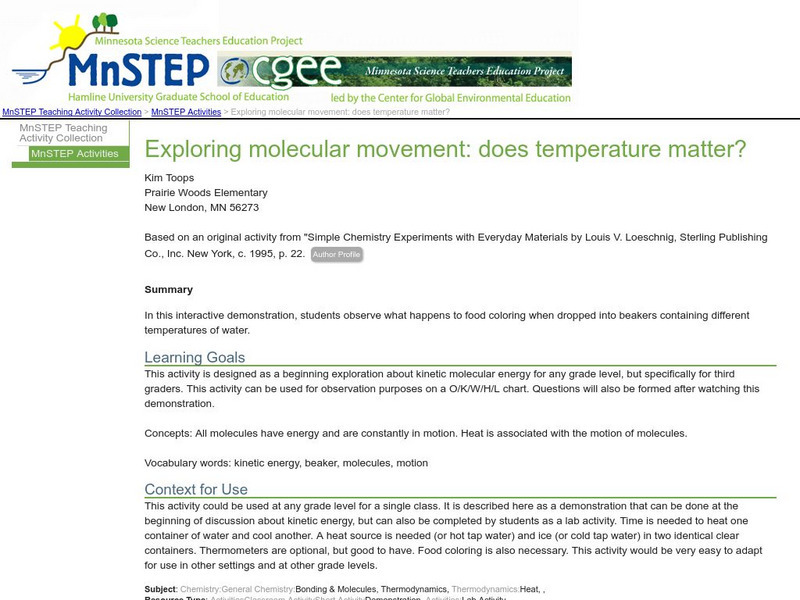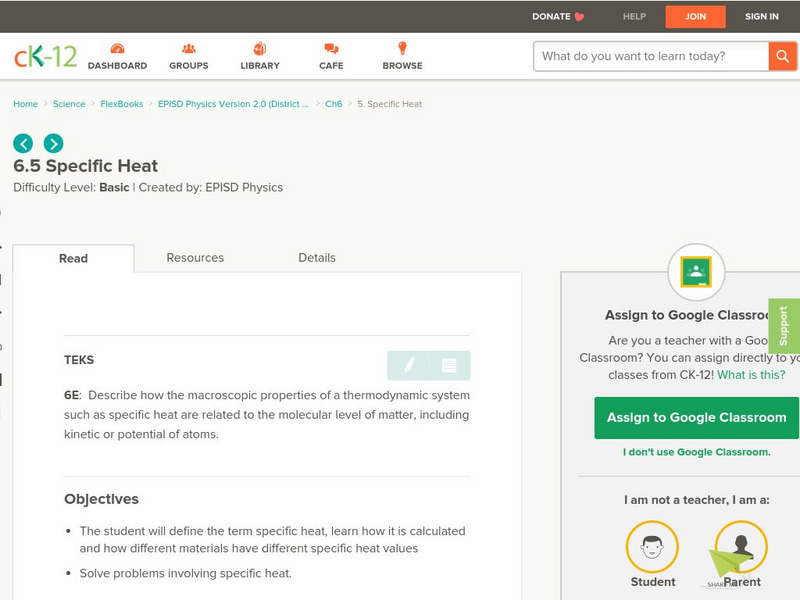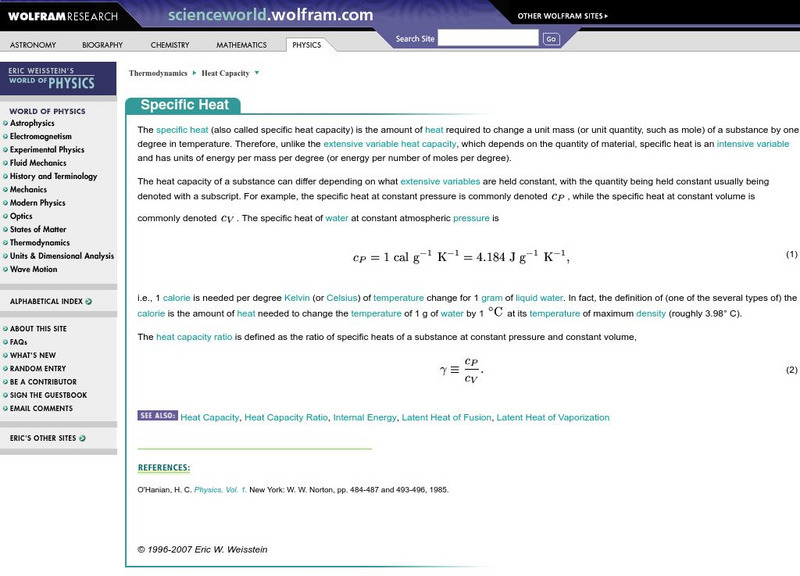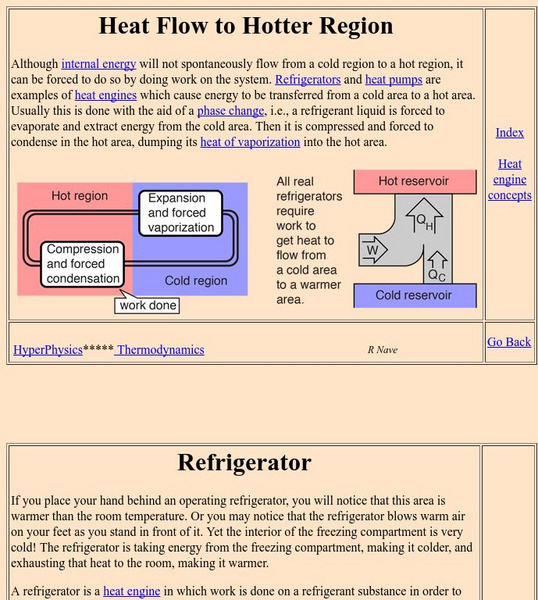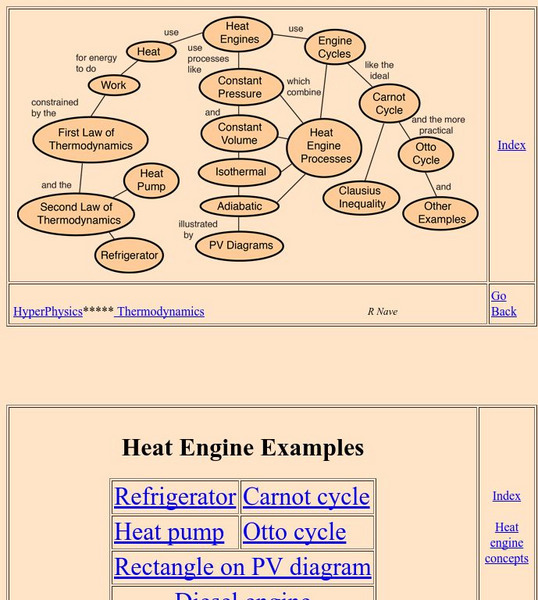TED Talks
Ted: Ted Ed: Two Objects Same Room Two Different Temperatures?
How can two objects have the same temperature but feel like they have different temperatures? Veritasium explores this phenomenon. [4:00]
Science Education Resource Center at Carleton College
Serc: Exploring Molecular Movement: Does Temperature Matter?
In this interactive demonstration, young scholars observe what happens to food coloring when dropped into beakers containing different temperatures of water.
Science Education Resource Center at Carleton College
Serc: Exploring Molecular Movement: Does Temperature Matter?
In this interactive demonstration, students observe what happens to food coloring when dropped into beakers containing different temperatures of water.
Simon Fraser University
Chem1 Virtual Textbook: Absolute Temperature
The General Chemistry Virtual Textbook, or Chem 1, is broken into several sections covering various aspects of topics related to chemistry. This section deals specifically with absolute temperature and absolute zero in relation to...
The Wonder of Science
The Wonder of Science: Ms Ps3 4: Thermal Energy Transfer
Work samples, phenomena, assessment templates, and videos that directly address standard MS-PS3-4: thermal energy transfer.
The Wonder of Science
The Wonder of Science: Ms Ps3 5: Energy Transfer to or From an Object
Work samples, phenomena, assessment templates, and videos that directly address standard MS-PS3-5: energy transfer to or from an object.
American Chemical Society
Middle School Chemistry: Heat, Temperature, and Conduction
Explore heat, temperature, and the conduction of thermal energy through different materials.
CK-12 Foundation
Ck 12: Heat Transfer
[Free Registration/Login may be required to access all resource tools.] Students explore the relationship between heat and energy transfer, and learn about the three ways that heat can be transferred between objects of different...
TeachEngineering
Teach Engineering: Heat Transfer: No Magic About It
Heat transfer is an important concept that is a part of everyday life yet often misunderstood by students. In this activity, students learn the scientific concepts of temperature, heat, and the transfer of heat through conduction,...
TeachEngineering
Teach Engineering: Efficiency of a Water Heating System
Students use a watt meter to measure energy input into a hot plate or hot pot used to heat water. The theoretical amount of energy required to raise the water by the measure temperature change is calculated and compared to the electrical...
CK-12 Foundation
Ck 12: Specific Heat
[Free Registration/Login may be required to access all resource tools.] Students explore the concept of specific heat, learn how it is calculated, and find out how different materials have different specific heat values.
American Chemical Society
Middle School Chemistry: Heating and Cooling a Liquid
This simulation allows students to make observations about how particle motion changes as the overall temperature of a liquid changes.
Georgia State University
Georgia State University: Hyper Physics: Heat Engine Concepts: Carnot Cycle
The Carnot cycle is described, illustrated and explained. The Carnot efficiency equation is given and interactive JavaScript form allows the visitor to investigate the effect of the reservoir temperature and the sink temperature upon the...
Wolfram Research
Wolfram Science World: Specifiic Heat
This site has information on specific heat,the amount of heat required to change a unit mass of a substance by one degree in temperature. Included are many links and formulas.
Georgia State University
Georgia State University: Hyper Physics: Heat Pump
Heat flow from a hot region to a cold region is described and explained. Applications of this phenomenon (specifically heat pumps and refrigerators) are discussed. Excellent graphics.
Georgia State University
Georgia State University: Hyper Physics: Heat Flow to Hotter Region
Heat flow from a hot region to a cold region is described and explained. Applications of this phenomenon (specifically heat pumps and refrigerators) are discussed. Excellent graphics.
Georgia State University
Georgia State University: Hyper Physics: Heat Engine Cycle
The heat engine cycle is defined and discussed. So pressure-volume diagrams are introduced and their use in depicting the cycles of a heat engine is demonstrated. Informative graphics are accompanied by reason-filled explanations.
Georgia State University
Georgia State University: Hyper Physics: Heat Engine Concepts
An indexing page for the HyperPhysics site. The page contains a concept map of links to a variety of other pages which discuss concepts related to heat engines. All pages contain informative graphics and excellent explanations.
Chem Tutor
Chemtutor: Heating Curve Problems
Nice set of problems dealing with the concept of a heating curve. Students can click on the question and get immediate feedback on their answer.
New York University
New York University: Measurement of Energy
Provides information about the distinction between heat and temperature, and allows you to check your understanding through exercises. The Kelvin, Fahrenheit, and Celsius temperatures are compared and discussed.
Mocomi & Anibrain Digital Technologies
Mocomi: Fun Facts About Temperature
Learn about units of temperature and other interesting facts.
CK-12 Foundation
Ck 12: Heat
[Free Registration/Login may be required to access all resource tools.] In this online lesson students will describe how the macroscopic properties of a thermodynamic system such as temperature, specific heat, and pressure are related to...
Climate Literacy
Clean: Hurricanes as Heat Engines
In this activity, students examine the effects of hurricanes on sea surface temperature using NASA data. They examine authentic sea surface temperature data to explore how hurricanes extract heat energy from the ocean surface.
Physics Classroom
The Physics Classroom: Thermal Physics: What Is Heat?
This physics tutorial is devoted to understanding how the relative temperature of two objects affects the direction that heat is transferred between the two objects.


